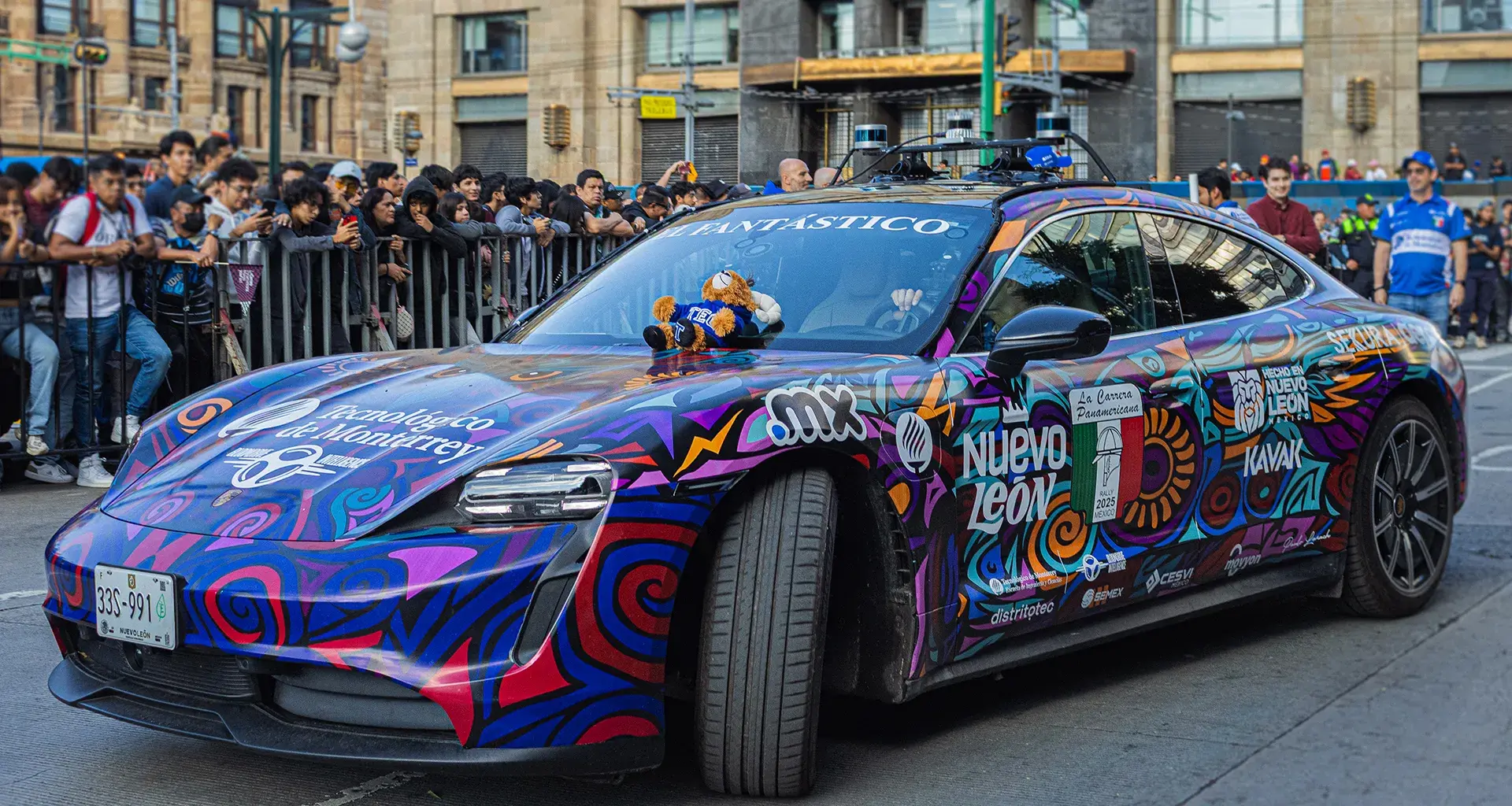The steering wheel turns on its own. The pedals move without anyone touching them.
Luis “Chapulín” Díaz —a legend of Mexican motor racing who’s accustomed to opening the throttle— is now holding back.
For the first time in his life, he doesn’t have to drive. He raises his hands, smiles, and waves to the audience. The car does the rest.
He’s part of a team that’s running the first self-driving vehicle developed by the Polytechnic University of Milan in the Carrera Panamericana. Next to it is El Fantástico, the self-driving vehicle’s lead car, which was developed by Tec de Monterrey.

“We wanted to go beyond the laboratory and apply the technology to real-world problems, help create regulations for Latin America, and bring innovation closer to industry and governments,” says Jorge Lozoya, leader of the Tec’s Bloom Drive Intelligence research group, who developed the lead car together with Tec professors and students.
The team joined forces with the Polytechnic University of Milan with the same goal: to have Mexico to participate in the global revolution of smart mobility.
“This race is like a living laboratory for us”. - Jorge Lozoya
The first self-driving vehicle in the Carrera Panamericana
For the first time in the history of the Carrera Panamericana, a self-driving vehicle is taking part in the race, and Tec de Monterrey is participating in the project.
The initiative aims to demonstrate the potential of smart mobility and generate data that will contribute to the development and regulation of this technology in Mexico.
This vehicle will travel between 300 and 400 kilometers in self-driving mode out of the 3,500 kilometers of the race, on sections controlled for safety.
The pits, set up at Tec campuses along the route, such as Puebla, Querétaro, León, Aguascalientes, and Santa Fe, function as living laboratories where teams from the Tec and the Polytechnic University of Milan recharge the cars, download information from the sensors, and verify calibration of the systems.
In addition, Lozoya explains that the vehicles will become open classrooms on each campus, bringing this technology closer to students and inspiring new generations to join the mobility of the future.
Tec de Monterrey’s Santa Fe campus was one of the official stops on the 2025 Carrera Panamericana and the setting for the starting flag.
From there, El Fantástico and the self-driving vehicle began their road trip to the center and north of the country.
In addition, demonstrations of the self-driving system and activities with students and the general public were held on campus.
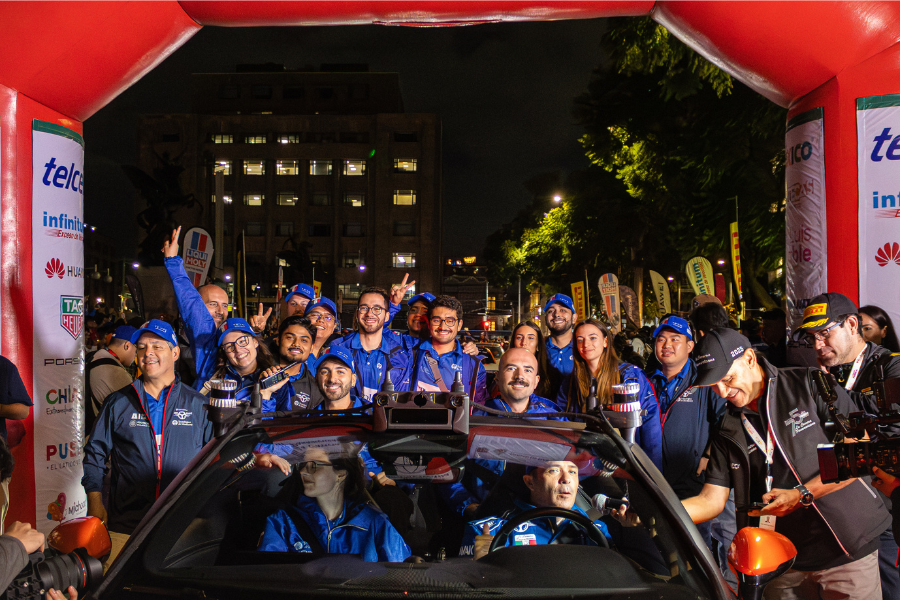
The technology behind the self-driving car
The self-driving vehicle, developed by the Tec and the Polytechnic University of Milan, was led by “El Fantástico,” also created by both institutions.
It has no driver. There is science, cables, sensors, and algorithms that think at 60 kilometers per hour—pure engineering.
The car is equipped with 10 sensors that function as the eyes and ears of the system:
- 3 LIDAR (laser) sensors: these measure distances and create a three-dimensional map of the environment.
- 3 radars: these detect objects and their speed, even in low visibility conditions.
- 3 RGB cameras: these capture color images to recognize signs, lines, and obstacles.
- 1 inertial motion unit: this measures acceleration and orientation of the vehicle.
“These sensors are part of the perception layer, which allows the vehicle to see and understand its surroundings”, explains Jorge Lozoya.
Next comes the decision-making layer, with two onboard computers: one analyzes the data and determines where to go and at what speed; the other converts those commands into electrical signals that move the pedals and steering wheel.
To enable the car to “feel” the road, the Mexican and Italian team designed a system that merges all this information in real time with maps of the surrounding area.
Thus, the self-driving vehicle can follow its lead car —El Fantástico—replicating its trajectory with controlled autonomy.
“When it’s in self-driving mode, you see the pedals moving on their own and the steering wheel turning on its own. Everything happens thanks to electrical actuators, pistons, and a rotational motor in the steering shaft,” explains Lozoya.
When the Panamericana becomes a living laboratory
Behind every cable and sensor is a team of around 27 people: engineers, researchers, drivers, and technical support specialists.
The operational core consists of 10 to 15 engineers from Tec de Monterrey and the Polytechnic University of Milan—including three doctoral students and two master’s students—who are responsible for installing, calibrating, and testing the vehicle’s self-driving systems.
They are joined by Italian engineers who went to Puebla to fine-tune the Maserati before the race, along with driver Luis “Chapulín” Díaz and the staff who document each stage of the route.
The Tec and PoliMi convoy moves forward like a technological caravan. At the front, El Fantástico leads the way and guides the Tec-Polimi self-driving vehicle, which follows its movements with millimeter precision thanks to its sensors.
Behind them, three vans transport engineers, doctoral students, technicians, and communicators who monitor each section of the Carrera Panamericana.

Over seven days, the route passes through Chiapas, Oaxaca, Puebla, Querétaro, Aguascalientes, and Zacatecas, before reaching the north of the country.
In each state, the Tec and Politecnico di Milano teams review the systems, collect data, and prepare for self-driving tests.
The pits, installed on Tec campuses along the route—such as Puebla, Querétaro, León, and Aguascalientes—are much more than technical stops.
“For us, the pits are living laboratories,” explains Jorge Lozoya. “We recharge the electric vehicles there, download data from the sensors, verify calibration, and take the opportunity to teach students about the technology. It’s where racing and research come together”.
The cars become open classrooms at these points.
“The pits are strategic,” says Jorge Lozoya. “There, El Fantástico and the self-driving car rest, recharge, and start up again. This is where we measure progress and also where we inspire new generations to join the mobility of the future".
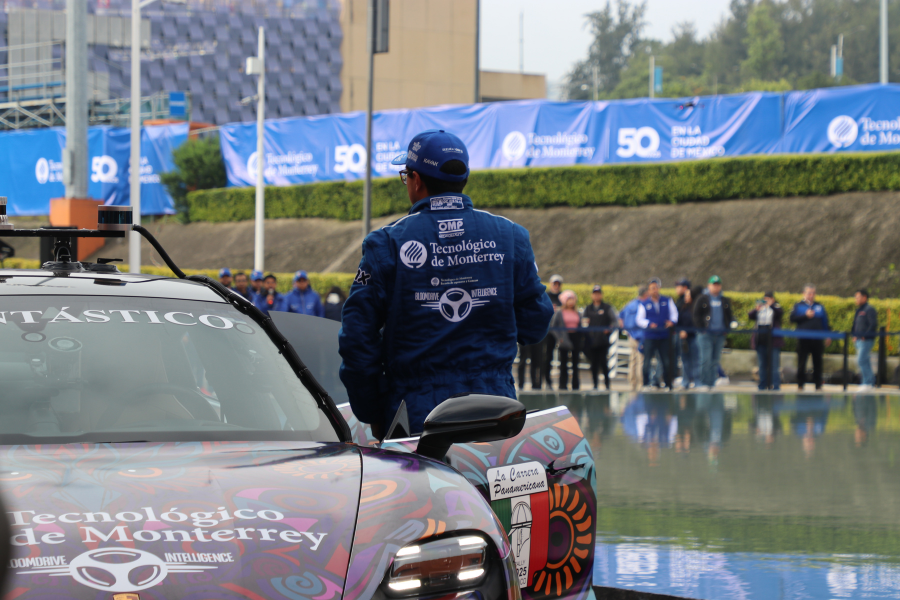
Why is there a self-driving car in the Carrera Panamericana?
The car isn’t just competing: it measures, records, and learns.
Every kilometer generates information about Mexican roads, weather conditions, energy consumption, and safety.
“We want to understand how a self-driving electric vehicle behaves in real environments, where sometimes there is no cellphone signal or well-defined roads,” says Lozoya.
“Everything we record will help us analyze road conditions and vehicle dynamics. With this information, we’ll be able to support the authorities in creating future regulations for Mexico.”
During the race, the system will capture data using laser sensors, radar, and cameras. It will record every turn, every braking maneuver, and even the impact of potholes.
The results will form a pioneering database in Latin America on self-driving mobility, which will be used for research and doctoral theses.
“What the students program or design is tested on the road. We want to train the next generations of engineers and scientists who will develop the mobility of the future,” explains the Tec academic.
“For many, it’ll be the first time their algorithms are put to the test at 60 km/h on the open road,” says Ismael Vidal, technical leader of the project.
According to Jorge Lozoya, the goal is to complete in self-driving mode between 300 and 400 km of the 3,500 km that the Carrera Panamericana covers.
The main limitation is safety: the self-driving vehicle cannot exceed 60 km/h, so the self-driving sections will be concentrated on departures and arrivals from cities and in the Tec pits/campuses.
In addition, although not everything will be self-driving, they plan to record data even when the vehicle is driven by humans with the aim of driving at least 1,000 km for research purposes.
The first step toward smart mobility in Mexico
The Carrera Panamericana is just the beginning. Both the Tec and the Polytechnic University of Milan plan to use the data collected for new electrical mobility and self-driving projects on campuses and in smart cities.
“The next step will be to fully automate El Fantástico and repeat the experience every year, covering more kilometers in self-driving mode,” according to Jorge Lozoya.
“We wanted to go beyond the laboratory and apply technology to real problems, bringing innovation closer to industry and governments”. – Jorge Lozoya.
In December, the Tec team will launch its Future Clean Mobility District in Monterrey, where students will be able to commute daily using self-driving transportation.
Italian researcher Sergio Savaresi, founder of the AIDA project, summarizes the shared vision:
“The mobility of the future will be a service, not a possession. Also, there can be no mobility as a service without autonomy”.
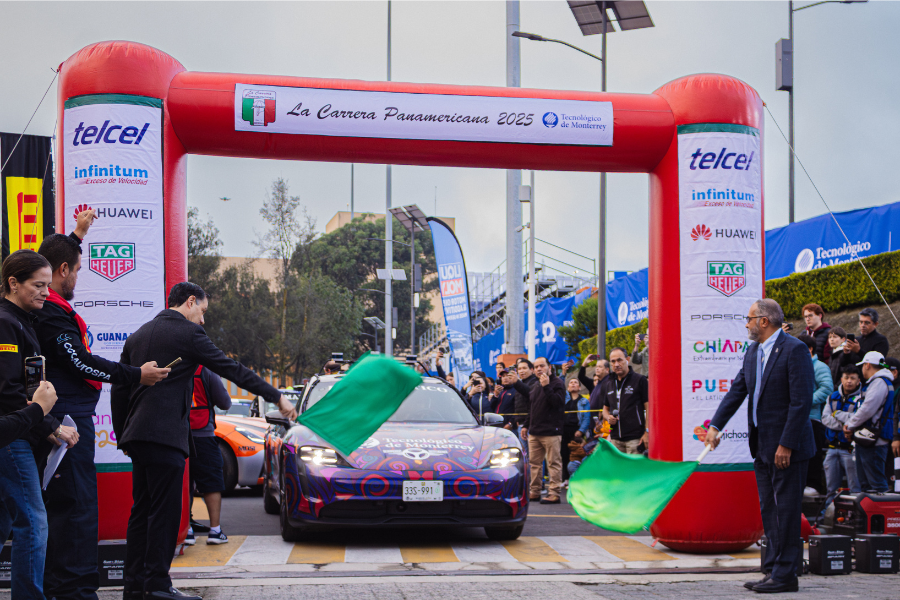
A project born from a shared vision
“This project was born out of a friendship and a shared vision with the Polytechnic University of Milan more than 13 years ago,” says Jorge Lozoya, leader of the Tec’s Bloom Drive Intelligence research group.
“We wanted to go beyond the laboratory and apply technology to real problems, help create regulations for Latin America, and bring innovation closer to industry and governments.”
This partnership gave rise to a challenge: to compete in the 2025 Carrera Panamericana with the first self-driving vehicle in the history of rallying:
- The self-driving car project for the Carrera Panamericana began to take shape in 2019-2020, when Lozoya and Professor Sergio Savaresi (Polimi) combined their research into smart mobility and electric vehicles.
- By 2022, the Tec already had its own self-driving laboratory vehicle in the Future Clean Mobility District.
- In January 2025, the Panamericana project became the Tec Mobility Research Group’s flagship project, and intensive work has been carried out on adapting both vehicles since then.
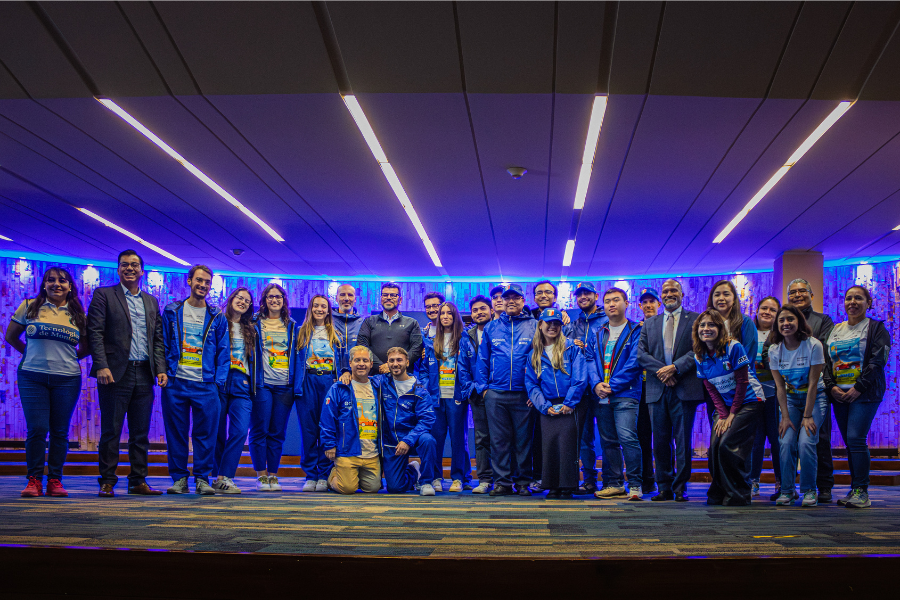
Luis “Chapulín” Díaz, a driver with extensive experience in endurance racing, was invited to take part in the race.
“I didn’t understand anything at first. However, when I found out we were going to be the first to run a self-driving vehicle, I said, ‘Let’s do it’”.
His role is crucial: he is the team captain and the human backup for the self-driving vehicle.
For decades, his instinct has been to turn the steering wheel, feel the traction, and react in milliseconds.
Now, his biggest challenge is not to do so.
The challenge is not physical, but mental. “It’s strange because you’re driving with your mind, not your hands. Your body wants to react, but you have to trust the system. You pay attention to every movement of the steering wheel, the pedal that sinks on its own, the noise of the engine... and yet, you can’t touch anything,” he says.
On the road, “Chapulín” moves between the lead car and the self-driving car, communicating with the engineers by radio.
“There are times when people don’t know it’s self-driving, and they get in your way. You have to react quickly there. However, the most impressive thing is seeing the steering wheel move on its own, realizing that the car is thinking. It’s the future".
About the Carrera Panamericana
The Carrera Panamericana began in 1950 to celebrate the inauguration of the Pan-American Highway, and the race soon became one of the most famous rally races in the world.
In its early editions, it brought together drivers from more than 15 countries and iconic brands such as Porsche, Ferrari, Mercedes-Benz, and Lincoln, who tested the power of their cars here on more than 3,500 kilometers of Mexican curves, mountains, and deserts.
Today, it crosses seven states: Chiapas, Oaxaca, Veracruz, Puebla, Querétaro, and Zacatecas, and is recognized as one of the most demanding classic routes on the planet.
YOU’LL ALSO WANT TO READ:

